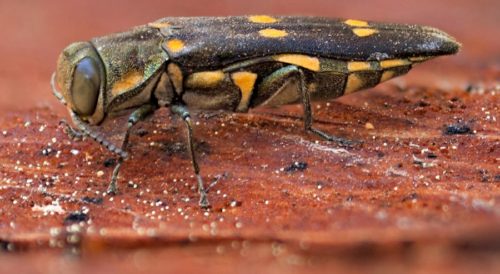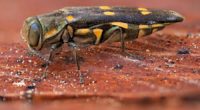
 Sugarloaf, CA – The invasive goldspotted oak borer (GSOB, Agrilus auroguttatus) was detected last week in recently-killed and dying California black oaks on private property in the unincorporated San Bernardino County community of Sugarloaf. Larval, pupal and adult life stages of the beetle were extracted by the California Department of Forestry and Fire Protection (CAL FIRE) and U.S. Forest Service personnel from under the tree bark. A San Bernardino County Fire Hazard Officer, who had received GSOB identification training, made the initial discovery while conducting hazard inspections. This is the second GSOB infestation identified in San Bernardino County, the first discovery being in the Oak Glen area in fall of 2018. This is also the second GSOB infestation on the San Bernardino National Forest, the first being in Idyllwild in 2012.
Sugarloaf, CA – The invasive goldspotted oak borer (GSOB, Agrilus auroguttatus) was detected last week in recently-killed and dying California black oaks on private property in the unincorporated San Bernardino County community of Sugarloaf. Larval, pupal and adult life stages of the beetle were extracted by the California Department of Forestry and Fire Protection (CAL FIRE) and U.S. Forest Service personnel from under the tree bark. A San Bernardino County Fire Hazard Officer, who had received GSOB identification training, made the initial discovery while conducting hazard inspections. This is the second GSOB infestation identified in San Bernardino County, the first discovery being in the Oak Glen area in fall of 2018. This is also the second GSOB infestation on the San Bernardino National Forest, the first being in Idyllwild in 2012.
The long-range spread of GSOB from its native range in Arizona to San Diego, then Riverside, Orange, Los Angeles counties and, now, San Bernardino County, has been attributed to the movement of GSOB-infested firewood. Therefore, it is critical to take precautions to avoid transporting potentially-infested oak firewood within, to, or from the San Bernardino Mountains.
GSOB may already be in other portions of San Bernardino County but haven’t been discovered yet. These non-native beetles aggressively attack California black oaks, coast live oaks and even canyon live oaks, whether in mountain communities, forests, valleys or cities. To make matters worse, GSOB prefer larger oaks, the very trees we depend on for beauty, shade and wildlife habitat.
Learn about GSOB at www.GSOB.org, including how to identify and report a suspected GSOB infestation. If you have oak trees that have recently died and have been cut down, it’s critical to make sure the wood is not infested before transporting it! The GSOB website has information on how to manage infested wood.
CAL FIRE, the San Bernardino National Forest and other collaborating agencies will develop a GSOB response plan for the mountaintop communities in San Bernardino County. This will include determining the current extent of the infestation in the area. In the interim, at-risk communities should educate themselves about the GSOB threat and share the information with their neighbors and friends in any San Bernardino County communities with oak trees.


